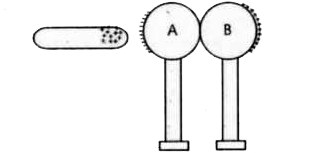Text Solution
Verified by Experts
|
Topper's Solved these Questions
ELECTRIC CHARGES AND FIELDS
NEW JOYTHI PUBLICATION|Exercise Previous Year Questions|3 VideosView PlaylistELECTRIC CHARGES AND FIELDS
NEW JOYTHI PUBLICATION|Exercise Competitive Exam Corner|20 VideosView PlaylistELECTRIC CHARGES AND FIELDS
NEW JOYTHI PUBLICATION|Exercise Solution To Exercises From NCERT Text|26 VideosView PlaylistDUAL NATURE OF RADIATION AND MATTER
NEW JOYTHI PUBLICATION|Exercise COMPETITIVE EXAM CORNER|15 VideosView PlaylistELECTROMAGNETIC INDUCTION
NEW JOYTHI PUBLICATION|Exercise COMPETITIVE EXAM CORNER|13 VideosView Playlist
Similar Questions
Explore conceptually related problems
Knowledge Check
A
B
C
D
Submit
A
B
C
D
Submit
Similar Questions
Explore conceptually related problems
NEW JOYTHI PUBLICATION-ELECTRIC CHARGES AND FIELDS -Evaluation Questions And Answers
- A glass rod rubbed with silk is brought close to two uncharged spheres...
05:08
|
Playing Now - Although ordinary rubber is an insulator, the special rubber tyres of ...
02:10
|
Play - Vehicles carrying inflammable material usually have metallic ropes tou...
02:38
|
Play - Is Coulomb a very big unit of charge?
01:53
|
Play - The electric field can be studied in terms of electric field intensity...
03:49
|
Play - Show mathematically that the electric field strength due to a short el...
01:39
|
Play - What is the total force acting on the dipole placed in a uniform elect...
01:00
|
Play - What is the effect of keeping the dipole in the field?
01:21
|
Play - What happens if the field is not uniform?
01:02
|
Play - The following four insulating spheres contain magnet, dipole, proton a...
02:27
|
Play - How does the electric field (E) vary with distance (r) in the followin...
03:33
|
Play - Give the expression for the time-period of oscillation of an electric ...
03:16
|
Play
